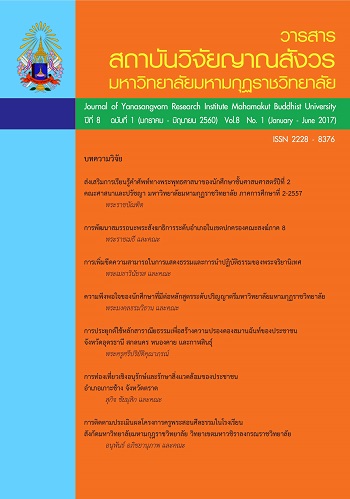AN INCREASING IN COMPETENCY OF BUDDHA’S DHAMMA MISIONARIES FOR TEACHING BUDDHIST DHAMMA AND LEADING BUDDHIST MEDITATION PRACTICE
Main Article Content
Abstract
The objectives of this research were as follows; 1) to study the state of competency in Dhamma preaching and Dhamma practice leading of Buddhist Missionaries. 2) to study the factors which were effected to addition of Dhamma preaching and Dhamma practice leading. 3) to examine the form and recommendation on competency in Dhamma preaching and Dhamma practice leading. The population were composed of two groups i.e. 1) the Buddhist missionaries for 151 persons. 2) the scholars which were concerned with Buddhist missionaries’ affairs for 30 persons. The instruments for this research were questionnaire and questions for in-depth interview. The statistics were applied as follows; mean, standard deviation and co-relation of Peasons’ method for table description. The findings were found as follows; 1) The state of competency in Dhamma preaching and Dhamma practice leading of Buddhist missionaries by overview was at more level when considered in each aspect found that there were at more level for all aspects from more to less i.e. the aspect of Dhamma 2) The factors were effected to competency in Dhamma preaching and Dhamma practice leading of Buddhist missionaries by overview being at more level when considered in each aspect found that there were at more level for all from more to less as following; the aspect of work skilling and satisfaction was the highest mean and followed up the aspect of taking care of commander, the aspect of work satisfaction and the aspect of welfare and merit renunciation respectively. 3) The hypothesis test, found that the relation between factors which were effected to competencies addition and state of competencies in Dhamma preaching and Dhamma practice leading of Buddhist missionaries had related in positive mostly high (rxy = 0.647) as the statistically significance at 0.01 or had related along with each other’s which were accordance with hypothesis setting and when considered the relation in each aspect found that there was positive relation well. 4) The form of competency addition found that the Buddhist missionaries should learn on short or long terms course ex. the curriculum of ecclesiastic administration, curriculum of Dhamma preaching etc., there should train on technological competency development for yearly to increase of work effectiveness and new experiences and there should have pre-training of work before working. and 5) The suggestions in competencies addition found that the should create budget as budget as enoughable and accordance with the real state of work. To arrange for competencies to Buddhist missionaries for their skilling in Buddhism disseminations to plan for information strategy in clear and coverage of purposive group and there should have promote on competencies and effectiveness in work performance of Buddhist missionaries as continuously.
Article Details
References
ปราณสุวีร์ อาวอร่ามรัศมิ์. (2552). บทบาทและหน้าที่ของพระจริยานิเทศก์. กรุงเทพฯ : กองพุทธสารนิเทศ สำนักงานพระพุทธศาสนาแห่งชาติ.
สมพงษ์ เกษมสิน. (2541). การบริหาร. กรุงเทพฯ : สำนักพิมพ์ไทยวัฒนาพานิช.
สุกัญญา รัศมีธรรมโชติ. (2549). แนวทางการพัฒนาศักยภาพมนุษย์ด้วย Competency Based Learning.พิมพ์ครั้งที่ 4. กรุงเทพฯ : ศิริวัฒนา อินเตอร์พริ้นท์ จำกัด (มหาชน).
บุญศรี พานะจิตต์. (2550). เอกสารประกอบการบรรยายงานประชุมพระสังฆาธิการ. นครปฐม :สำนักงานพระพุทธศาสนาแห่งชาติ.


